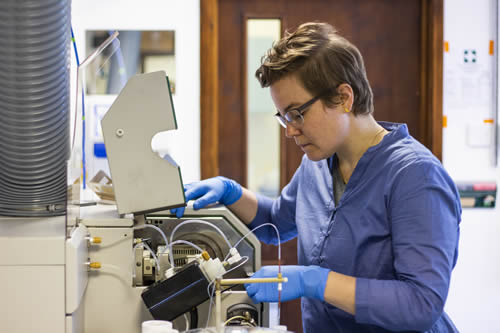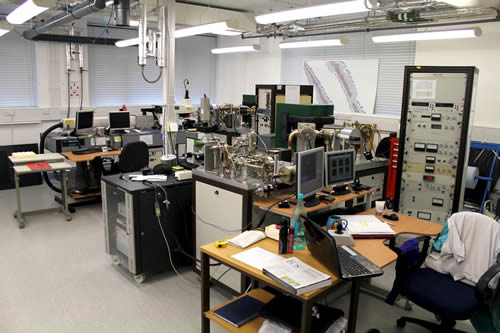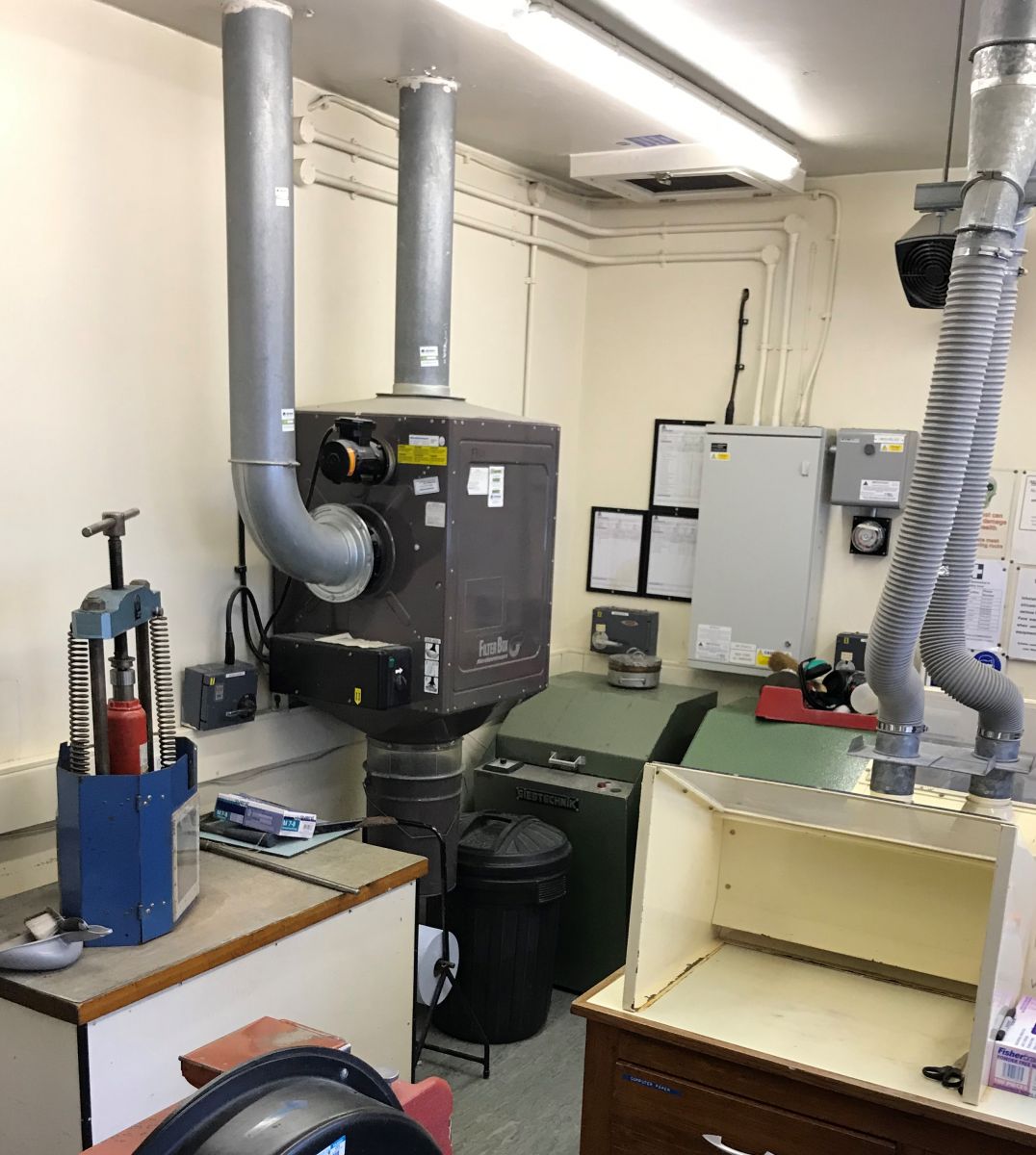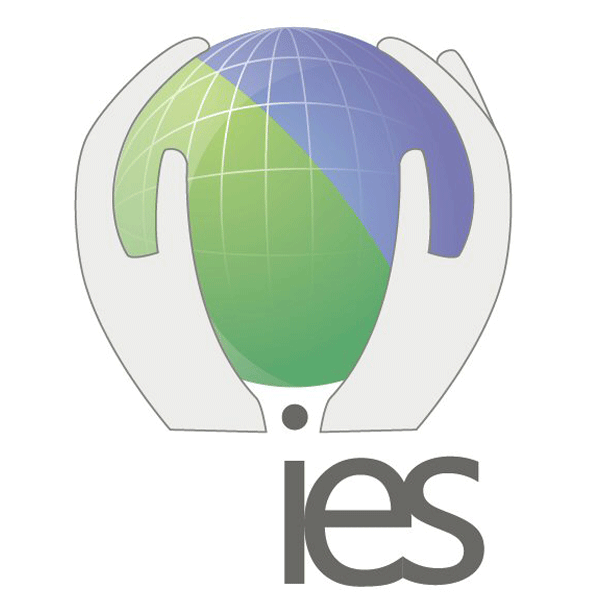Earth Science Laboratories
The Earth Science Laboratories support the preparation and chemical analysis of a range of Earth materials such as rocks, fossils and minerals.
We support OU research and are also able to offer commercial analysis and development work where capacity allows.
The laboratories comprise analytical instruments and preparation facilities in the following areas:
- Mass spectrometry;
- Geochemical clean labs;
- Electron microscopy;
- Elemental analysis;
- Optical microscopy facility;
- Sample preparation facilities.
1. Mass Spectrometry
1.1 Solution ICP-MS
Our Agilent 7500 and Agilent 8800 ICP-QQQ instruments allow us to analyse the full range of trace elements from lithium to uranium, in a wide variety of geological and environmental samples (rock digests, soils, waters).

The Agilent 7500 is used for the determination of routine trace element concentrations at the ppm to sub-ppb -level with a precision of better than 3%.
The Agilent 8800 ICP-MS/MS offers an order of magnitude increased sensitivity compared to the 7500 ICP-MS, allowing for the analysis of much smaller samples, or less abundant elements (ppt level concentrations).
The triple quad configuration allows for the targeted removal of complex polyatomic and doubly charged interferences on analyte masses which have been traditionally difficult to analyse (e.g. Ag, S, Se).
1.2 Laser ablation ICP-MS
Our ICP-MS instruments can be coupled to our Photon Machines Analyte G2 193 nm excimer laser system equipped with a HelEx II 2-volume cell. This set up allows us to load either four standard glass slides plus three grain mounts or nine grain mounts into the laser cell at once.
The small cup in which the ablation takes place allows for optimal aerosol transport and very fast washout. In addition, the Teledyne Aerosol Rapid Introduction System (ARIS) increases signal transport and wash out speed significantly and allows full signal peak resolution for fast high-resolution laser mapping.
1.3 Ar/Ar and Noble gas mass spectrometry

Our MAP 215-50 and Nu Instruments Noblesse mass spectrometers are fully compatible with our mobile laser units including two Infra-Red fibre lasers, a Photon Machines 193nm excimer laser and a CO2 laser system.
Together these allow analysis of a wide range of materials. We are dedicated to developing and modifying techniques for dating ultra-small samples to high precision, and ultra-high resolution noble gas diffusion experiments.
1.4 Stable isotope mass spectrometry
The Stable Isotopes and Geochemistry Laboratory, equipped with a Thermo Delta and a MAT253 IRMS, is housed in the School of Physical Sciences and offers isotopic (C, O, N, H) analysis of organic (including compound specific isotope analysis) and carbonate terrestrial and extra-terrestrial samples including soil and sediments from ocean sediment cores, impact craters, lake beds, rock deposits, shells, plants, lunar samples and meteorites.
Please contact Sam Hammond (Sam.Hammond@open.ac.uk) (solution analyses), Barbara Kunz (Barbara.Kunz@open.ac.uk) (laser ablation analysis), Alison Halton (Alison.Halton@open.ac.uk) (Ar/Ar and noble gas analysis) or Simona Nicoara (Simona.Nicoara@open.ac.uk) (stable isotope analysis) for further information about the facilities.
.jpg)
2. Geochemical Clean labs
Our metal-free clean room suite contains PicoTrace Clean-Air workstations (class E XIV air supply), each fitted with an electronically controlled PTFE hotplate.
Each lab is supplied with a clean (>18.2 MΩ) water supply, and we have a designated weighing room (5 and 7 figure balances).
Overall, we can ensure a working environment that is clean for sample dissolution, and purification of chemical elements prior to isotopic or elemental measurements by mass spectrometry.
Please contact Sam Hammond (Sam.Hammond@open.ac.uk) for further information.
3. Electron Microscopy
.jpg)
3.1 Electron Microprobe Analyser (EMPA)
Our Cameca SX100 instrument has both WDS and EDS capability and can measure concentrations of most elements at ppm concentration and above. The holders can accommodate four thin sections or six 1-inch mounts for optimal analysis.
3.2 Scanning Electron Microscope (SEM)
We also use the Scanning Electron Microscope (SEM) instruments that are part of the OU's Electron Microscopy Suite. These SEMs may be used for high-resolution imaging, large-area mapping, EDS chemical analysis, and for EBSD and CL techniques.
Please contact Giulia Degli Alessandrini (Giulia.Degli-Alessandrini@open.ac.uk) for further information.
4. Elemental analysis
4.1 ICP-OES
Our inductively coupled plasma atomic/optical emission spectrometer (ICP-AES / ICP-OES) is used for elemental analysis of a wide variety of prepared aqueous samples and can report trace elements as well as major element constituents. It is used predominantly for identifying trace metals in environmental samples such as soil extracts, water samples, mixed chemical analysis and commercial projects.
The strengths of this instrument include high accuracy, auto-sampling, high reproducibility and reporting multiple elements at a time. This instrument is used for both research and commercial applications at the OU.
4.2 XRF
Our Niton XL3t handheld XRF instrument can be used for both field and laboratory-based measurements of elements in solid rock samples, sediments and powders. The instrument can analyse elements as light as Mg, Si and S, through to trace elements such as Pb, Mo and V. Detection limits are well below the average crustal composition for most measured elements.
Please contact Tim Barton (Timothy.Barton@open.ac.uk) for further information about the ICP-OES and Alison Halton (Alison.Halton@open.ac.uk) for further information about the XRF.
5. Optical Microscope Facilities
5.1 Microscope facilities
Our dedicated microscope facilities include microscopes for micropalaeonological analysis (palynomorphs, foraminifera, insects and diatoms) as well as petrographic microscopes for investigating rock thin sections, in both reflected and transmitted modes.
Our facilities also include an inverted microscope and micromanipulation system for the rapid picking of palynomorphs and other microfossils together with a six figure microbalance for weighing small samples, and an image analysis facility for measuring the size of microscopic shells.
5.2 Virtual Microscope
The Virtual Microscope broadens access to rock collections currently held in museums, universities and other institutions around the world. The virtual microscope allows users to examine and explore minerals and microscopic features of rocks, helping them to develop classification and identification skills without the need for high-cost microscopes and thin section preparation facilities.
Please contact Tom Argles (Tom.Argles@open.ac.uk) for further information about the Virtual Microscope.
6. Sample Preparation Facilities
6.1 Thin section laboratory
We produce standard and larger-sized thin sections of varying different materials, such as rock, pottery, meteorite, coal, clay, grains, single crystals, and building materials. We produce standard polished probe thin sections (25mm x 48mm) which can be de-mountable and doubly polished if required. Polished resin blocks of 1 inch diameter are also available. Samples can also be impregnated with resin, blue dyed, and stained for carbonates if required.

6.2 Rock crushing and mineral separation facilities
We have full capacity for crushing and separating minerals from rocks, including a rock splitter, jaw crusher, milling machines, heavy liquid facilities and a Frantz magnetic separator.
6.3 Sedimentary/palaeontology preparation
We host a dedicated suite of laboratories for the storage, preparation and analysis of sedimentary and palaeontological samples with facilities including a sediment core splitter, walk-in fridge for core storage, freezer, two extractor hoods for HF acid digestion of samples, a centrifuge, ovens, precision balances, water baths, hot plates, and a pure water supply.
Please contact Michelle Higgins (Michelle.Higgins@open.ac.uk) or Kay Knight (Kay.Knight@open.ac.uk) (for further information about the thin section laboratories.
If you have any questions or want to find out more about our Earth Science Facilities, please contact: David Johnson (David.N.Johnson@open.ac.uk).
News
Celebrating Graduation in Manchester
On 22 November Professors Clare Warren, Mark Brandon and Richard Holliman, and Dr Barbara Kunz travelled to Manchester for an OU Graduation Ceremony.
EEES researcher to lead £800k project to improve global climate change predictions
An EEES researcher is leading a new Natural Environmental Research Council-funded project to improve our ability to predict climate change using cutting-edge analysis of fossilised algae molecules.




